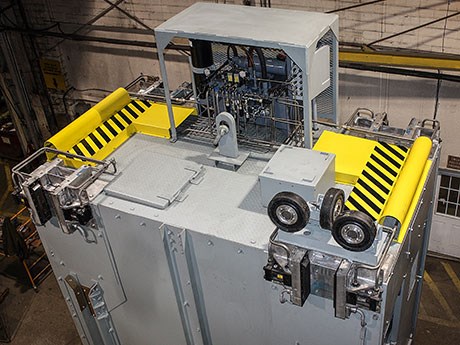Technology chairs cages for loading and offloading and functions as an emergency brake to arrest a free-falling conveyance
A new system that can hold mine cages in place and act as an emergency brake is being deployed by Wabi Iron and Steel Corp. at a Mexican gold mine.
Called Loc-N-Load, the technology is the result of nearly 16 years of research, design and development by the New Liskeard company. “We wanted to adopt a system that was dual purpose,” said Wabi president Stan Gorzalczynski. “It chairs the cage for loading and offloading activities and, if the hoist rope ever breaks, that exact same system is there to grab onto the guides and arrest the free-falling cage.”
Mining companies have long used safety dogs on mine cages to stop cages when a hoist rope or cable is severed, Gorzalczynski explained. This old technology, the most commonly used safety catch in Canada, relies on chisel-like devices that dig into wooden guides in the shaft to stop a plummeting cage. Wooden guides worked well when cages were relatively small, but cages are getting larger to transport heavy underground equipment and to move miners more efficiently, especially at depths of 5,000 to 6,000 feet. “Today it’s not rare to see a mine cage operating with a capacity of 170 people,” Gorzalczynski pointed out.
Even today, large mine cages are being designed with wooden guides in the shaft as the conventional safety dog is really the only recognized technology that offers controlled deceleration rates in a free-falling mine cage. Steel guides are also being specified for new mine shaft installations, however, when deciding to use steel over wooden guides, the decision to adopt multi-rope hoisting also has to be made and that greatly impacts the capital cost of the hoist plant.
Ontario and British Columbia have Canada’s most stringent requirements for mine cage protection and specific deceleration limits for safety catch systems. When a new nickel mine was developed in Sudbury, it was built with steel shaft guides precluding the use of safety dog technology. Mine designers solved the problem by installing a double rope hoisting system, at a cost many times more than that of Wabi’s new system.
Wabi’s Loc-N-Load equipment can prevent a cage from moving up or down during loading and unloading. When a mine cage on a single hoist rope is loaded with 20 tonnes of equipment at a depth of 5,000 feet, the weight can stretch the cable as much as five feet, Gorzalczynski estimates. “If you don’t secure the cage into position before you drive onto the deck and put that load there, you’ve got a very dangerous situation. If a fork lift carrying a heavy payload drove onto the deck of an unsecured cage, the cage would sink, causing the forklift to tilt, punch through the back of the cage and plunge down the shaft.”
Mines currently use mechanical systems to stabilize the cage - chains that attach to the cage or a foot that comes out of each cage corner and sits on a bulkhead. Although these mechanical systems prevent the cage from moving downward, they are heavy and have safety issues when being applied. “If you’re attaching chains to a cage, it’s very difficult to do that in the mine shaft,” Gorzalczynski said. “We wanted something that is very safe to apply, to engage and disengage, something that didn’t require anyone to be in the vicinity of the mine cage during its application because that can be a hazardous location.”
Wabi’s chairing system of battery powered hydraulic clamps can be applied with the push of a button on a control panel at the shaft station. “At that point, you’re securing the deck of the cage from going down. You’re also securing it from going up.”
He explained that when a cage has a 20-tonne load at surface and is then lowered underground to a depth of 5,000 feet, the hoist rope will contract once the cargo is removed, thrusting the cage upward. Mechanically chaining a cage won’t prevent it from thrusting upward.
“Loc-N-Load locks it. It won’t go up. It won’t go down. It’s secure and very easy to apply,” Gorzalczynski said. The same clamps that lock the cage for loading and unloading will activate in the event of a hoist rope break and safely decelerate the cage.
Wabi declined to disclose the name of the Mexican mine until its equipment is fully commissioned. While Mexico will have Wabi’s first operating system, the company sees other opportunities in Latin America. “The need for hoist rope severance protection extends throughout the Americas,” he said.
Wabi intends to get approval to operate its Loc-N-Load system in Ontario. The company has been working to that end with the Ontario Ministry of Labour and companies involved in engineering, procurement and construction management.



